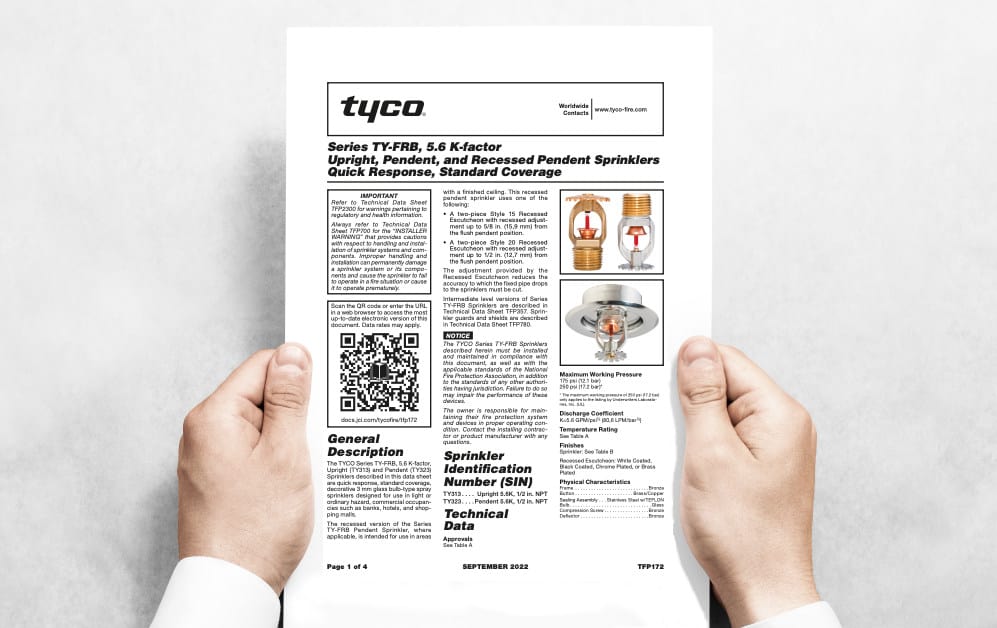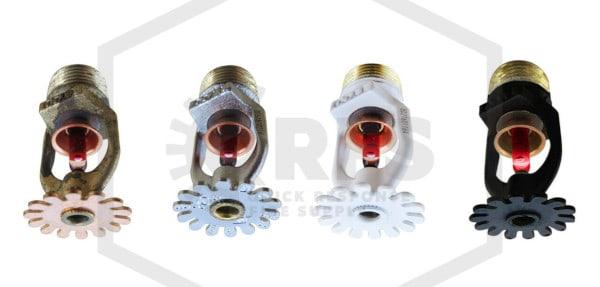Tyco sprinkler data sheets have a wealth of crucial info
Fire sprinkler data sheets are packed with essential information, from technical specs and installation instructions to listings and ordering guides. But they aren’t always easy to read, especially if fire protection isn’t your full-time job. This article, the second in a series, explains how to read Tyco sprinkler data sheets.
Tyco, owned by industry giant Johnson Controls, is one of the biggest fire sprinkler manufacturers in the world. As such, it’s published a ton of data sheets for both current sprinklers and legacy versions. As we explained in our previous blog on obsolete sprinklers, Tyco acquired several other major manufacturers over the years, including Grinnell and Star. And it’s absorbed or replaced various brands’ sprinkler heads within the Tyco catalog.
This blog focuses on interpreting the different parts of recent Tyco sprinkler data sheets—though some items apply to older ones. We cover:
- Understanding SINs and basic specs
- Technical drawings and the installation guide
- The laboratory listing and approval table
- Design criteria
- The ordering guide
If you’re looking for Tyco sprinklers (or data sheets), QRFS has you covered. Shop our catalog of residential and commercial Tyco sprinkler heads. When you find the model you want, just scroll toward the bottom of a product page to download the data sheet.
Not sure what part you need? Use the QRFS Quick Finder!
Understanding SINs and the basic specs for Tyco sprinklers
Every sprinkler model made after 2000 (and some prior) has a unique alphanumeric code called a sprinkler identification number (SIN).
It starts with one or two letters that indicate the manufacturer (Tyco SINs start with TY). Then, three to five numbers identify the specific sprinkler. One SIN corresponds with one kind of sprinkler head. For instance, the TY313 is an upright, quick-response, standard-coverage commercial sprinkler with a 5.6 K-factor.
Changing any one of those facts means that the SIN changes. You can learn more about SINs in our previous blog.
Unlike some manufacturers, Tyco often covers multiple SINs in one data sheet. So, to avoid confusion, first orient yourself by checking the document title, which summarizes the types of sprinklers in the data sheet, usually corresponding to a specific product line.
For example, the title below specifies “Series TY-FRB” sprinklers and the various features/subtypes of that series:

All sprinklers on a data sheet will still share some core features. In the above example, Tyco’s Series TY-FRB are all K=5.6, quick response, and standard coverage. For more info on this manufacturer’s different sprinkler series, check out our Guide to Tyco Fire Sprinklers.
So, the sprinklers in our data sheet example only fundamentally differ by the available orientations: upright vs. pendent (which can be installed recessed or non-recessed). These differences boil down to two SINs on one data sheet: the upright TY313 and the pendent TY323 (recessed or non-recessed).
The SINs are found within the main body of the data sheet’s first page:

Text and bullet points on the initial page also cover the compatible escutcheons, available finishes, and various technical information like maximum rated pressure and frame characteristics.
Technical drawings and the installation guide for Tyco fire sprinklers
Next, Tyco provides technical drawings and visual installation instructions. These figures are very handy, and not every manufacturer includes them.
Within this section are basic dimensions and a cross-section drawing of the sprinkler. It also gives you info about wrenches, telling you which ones to use and how to use them.
Lastly, this section gives you drawings of properly installed sprinklers with their escutcheons or cover plates. The first page already provided a list of approved escutcheons and cover plates; this section repeats some of that info while showing how much a sprinkler can recess with a given escutcheon or how far a cover plate can adjust.

Reading laboratory listing and approval tables
Listings and approvals are fundamental to the fire protection industry; these words essentially mean “effective” and “dependable.” Given the stakes in fire protection, many sprinkler system parts are tested by a certified laboratory such as UL or FM Global to prove they are reliable and functional.
Learn more about listings and approvals and authorities having jurisdiction in our previous blog posts.
But obtaining a listing for a sprinkler is not a one-size-fits-all affair. Different laboratories use different protocols for their tests and have different standards. That’s why UL and FM Global often “list” or “approve” unique maximum water pressures, for example. Plus, every version of a SIN (such as finish or temperature rating) and every unique sprinkler assembly (sprinkler-escutcheon or sprinkler-cover plate combination) has separate testing and listings.
Where possible, Tyco likes to give listing and approval information in text form. For example, its residential sprinklers (like the TY2236 pendent) aren’t FM-Approved at all; the data sheet only specifies that these models are UL-Listed.
Otherwise, Tyco may provide bullet points, such as in this example from the TY3531 concealed pendent:
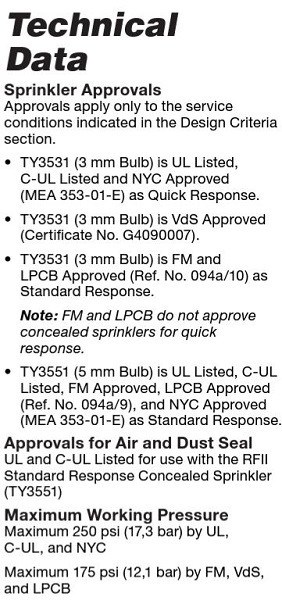
When there’s a lot of this information, the data sheet organizes everything into a “laboratory listings and approvals” table. These tables are surprisingly easy to read, even though Tyco likes to include multiple SINs in one document. Check out this example:

- The first two columns (marked (1) above) break things up by K-factor and sprinkler orientation/type—upright, pendent, recessed pendent, etc. Two of the letter superscripts in the “Type” column lead to footnotes about the escutcheons used in recessed installations.
- Each of these characteristics is further divided based on temperature (2), which also specifies the bulb color.
- Then, available finishes are separated into columns (3). The numbers in the rows below those columns correspond to footnotes that tell you which safety organizations list and approve which versions for what. The lone superscript letter next to the Polyester finish reveals info about it in the notes.
Design criteria in Tyco sprinkler data sheets
All Tyco data sheets include at least a note about system design criteria. System design is all about determining the placement of sprinklers, the flow rate and pressure needed from the water supply in light of a sprinkler’s K-factor, and other factors. It’s a complicated process that should be left to the pros—but check out our previous article on the subject for more info.
Most commercial systems‘ pertinent system design rules come from NFPA 13: Standard for the Installation of Sprinkler Systems. The main exception is that FM Global provides appropriate protection criteria for special scenarios. So, data sheets for commercial sprinklers include a brief note stating that sprinkler design criteria are either based on UL Listings (and UL always uses NFPA 13) or FM Global standards.
In contrast, Tyco fire sprinkler data sheets for residential sprinklers include more detailed design criteria for sprinkler spacing, water flow, and pressure. These figures look a lot like something found in NFPA 13. These sheets have this additional information because NFPA’s residential standards (NFPA 13R: Standard for the Installation of Sprinkler Systems in Low-Rise Residential Occupancies and NFPA 13D: Standard for the Installation of Sprinkler Systems in One- and Two-Family Dwellings and Manufactured Homes) don’t provide the same detail as NFPA 13.
Instead, they rely much more on the manufacturer and approval laboratory for design criteria. Here’s an example of the design criteria provided in the data sheet for a TY2236 residential pendent:
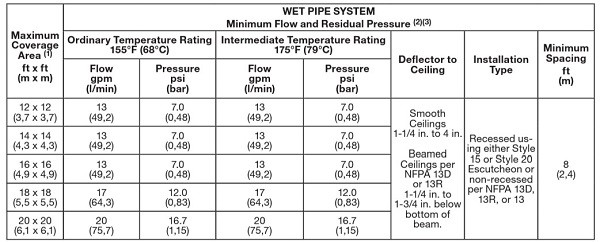
The Tyco fire sprinkler data sheet ordering guide
A SIN may identify a unique sprinkler design, but it’s not specific enough to place an order. Tyco uses a system of part numbers to keep track of different variations in finish or temperature. The data sheets provide a brief ordering guide, shown below:
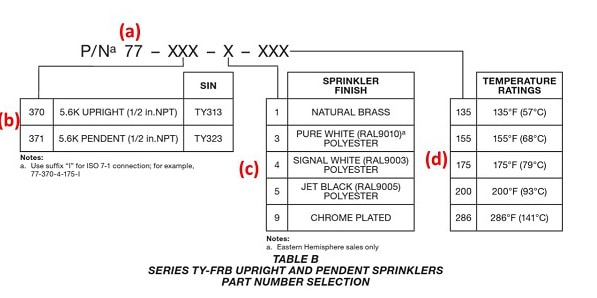
A Tyco part number looks like this: P/N XX – XXX—X—XXX. Breaking this string down:
- The letters “P/N” simply mean “part number.”
- The first two numbers, “XX,” are specific to the model of sprinkler you are ordering (“a” in the above figure).
- The following three numbers, “XXX,” indicate the orientation/type of sprinkler (“b”).
- The next single digit, “X,” marks the finish (“c”).
- Finally, the trailing three digits, “XXX,” indicate the temperature rating (“d”).
Combined, they look like this: P/N 77-370-3-135. That stands for a 5.6K bulb (“77”) upright TY313 sprinkler (“370”) with a pure white finish (“3”) and a 135°F temperature rating (“135”).
If the Tyco fire sprinkler data sheet only has one SIN, it won’t give you a guide like this. Instead, it will provide a bullet-point list.
Reading a Tyco fire sprinkler data sheet is straightforward—when you know how!
Tyco is an industry giant offering many sprinkler models. So, their data sheets can be a bit dense compared to other manufacturers. Nevertheless, we hope this article showed you that, with some careful reading, you can easily extract the details needed.
The essential specs, compatible wrenches, escutcheons, cover plates, installation instructions, approvals, design criteria, and ordering info are all there.
Information like this is valuable to sprinkler engineers, installers, and facilities managers alike. But if you simply need to find a specific sprinkler or its compatible wrench, escutcheon, or cover, FAST:
Use the QRFS Quick Finder!
Just enter the sprinkler identification number (SIN) and select the options needed, and it shows you the correct parts available for purchase.
Still have questions? Contact us at 888-361-6662 or support@qrfs.com.
This blog was originally posted at blog.qrfs.com. If this article helped you, check us out at Facebook.com/QuickResponseFireSupply or on Twitter @QuickResponseFS.


